
Euphorbia is a very large and diverse genus of flowering plants, commonly called spurge, in the family Euphorbiaceae. "Euphorbia" is sometimes used in ordinary English to collectively refer to all members of Euphorbiaceae, not just to members of the genus.

Euphorbia heterophylla, also known under the common names of Mexican fireplant, painted euphorbia, Japanese poinsettia, paintedleaf, painted spurge and milkweed, is a plant belonging to the Euphorbiaceae or spurge family.
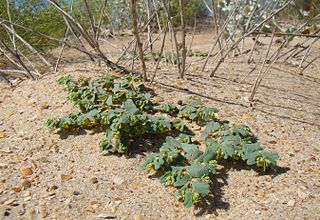
Euphorbia peplis, the purple spurge, is a species of Euphorbia, native to southern and western Europe, northern Africa, and southwestern Asia, where it typically grows on coastal sand and shingle.

Euphorbia arbuscula is a species of plant in the spurge family (Euphorbiaceae). It is endemic to the archipelago of Socotra in Yemen. Its natural habitats are subtropical or tropical dry forests and subtropical or tropical dry shrubland.
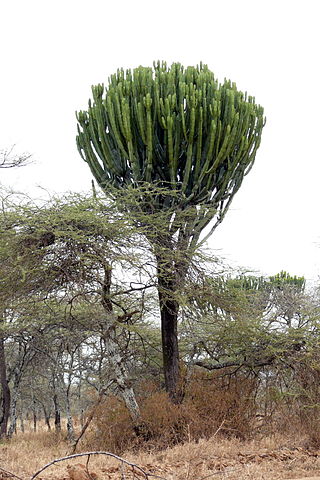
Euphorbia candelabrum is a succulent species of plant in the family Euphorbiaceae, one of several plants commonly known as candelabra tree. It is endemic to the Horn of Africa and eastern Africa along the East African Rift system. It is known in Ethiopia by its Amharic name, qwolqwal, or its Oromo name, adaamii. It is closely related to three other species of Euphorbia: Euphorbia ingens in the dry regions of southern Africa, Euphorbia conspicua from western Angola, and Euphorbia abyssinica, which is native to countries including Sudan, Eritrea, Djibouti, Ethiopia and Somalia.

Euphorbia balsamifera is a flowering plant in the spurge family Euphorbiaceae. It is distributed in the Canary Islands and the western Sahara. It is the vegetable symbol of the island of Lanzarote. Euphorbia adenensis has been treated as a subspecies of this species.

Lobelia rhombifolia, commonly known as tufted lobelia, is an annual plant from southern Australia. They range from 5 to 30 cm in height and produce purple flowers, with a white throat and two recurved upper lobes. The flowers appear at different times across their native range:
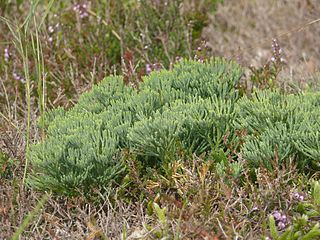
Diphasiastrum tristachyum, commonly known as blue clubmoss, blue ground-cedar, ground pine, deep-rooted running-pine or ground cedar, is a North American and Eurasian species of clubmoss. In North America, it has been found from Newfoundland west to Manitoba, and south as far as Georgia and Alabama. In Eurasia, it ranges from southern Norway and Sweden south to France and Italy and it also occurs in the Caucasus.

Euphorbia flanaganii, commonly known as Transkei medusa's head, is a succulent plant that belongs to the family Euphorbiaceae. It is endemic to South Africa. Due to the breadth of the Euphorbiaceae, little research specific to E. flanaganii has been conducted.

Euphorbia schinzii is a perennial Southern African, dwarf flowering plant belonging to the family Euphorbiaceae. It is found on rocky slopes, growing among rocks. Variable in form, it occurs in South Africa, Zimbabwe, Botswana, Mozambique and Malawi, at an altitude between 100 and 1500 meters. The genus Euphorbia is large, with over 2000 species of extremely diverse size and appearance, and with a global distribution.

Cadaba aphylla ("Swartstorm") is one of the many species in the genus Cadaba. It is indigenous to southern Africa.
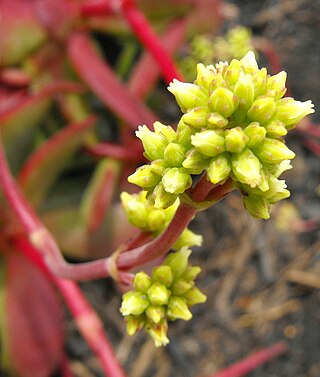
Crassula pubescens is a succulent plant, common and widespread in the southern Karoo regions of South Africa.
Pteronia glauca ("Geelboegoekaroo") is a species of flowering plant in the family Asteraceae, indigenous to the Karoo regions of South Africa.
Euphorbia tenax is a species of Euphorbia endemic to South Africa, where it occurs in the Northern Cape and Western Cape provinces, around Kotzesrus and southwards as far as Nieuwoudtville and Cape Town. Its preferred habitat is sand Fynbos and Succulent Karoo on shale-derived slopes.
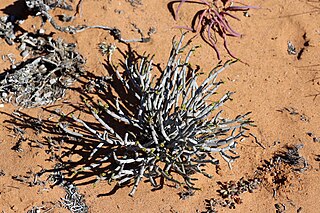
Euphorbia burmannii is a species of Euphorbia indigenous to Namibia and South Africa, where it is widespread in sandy soils, extending southwards to the Cape Peninsula and as far east as Grahamstown.

Drosanthemum lavisii is a succulent plant in the ice plant family, Aizoaceae, indigenous to the Overberg region of the Western Cape Province, South Africa.
Dianthus bolusii, called the mountain pink or bergangelier, is a species of flowering plant in the family Caryophyllaceae.

Dianthus caespitosus, called the Karoo pink or koperangelier, is a species of flowering plant in the family Caryophyllaceae.

Dianthus thunbergii is a species of flowering plant in the family Caryophyllaceae.
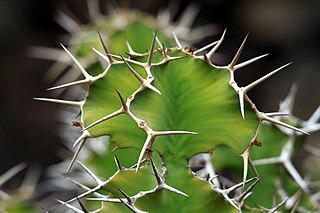
Euphorbia grandicornis, the cow's horn plant, is a succulent plant of the Euphorbiaceae or spurge family. It is native to the KwaZulu-Natal province and the Northern Provinces of South Africa and to Mozambique and Eswatini.


















